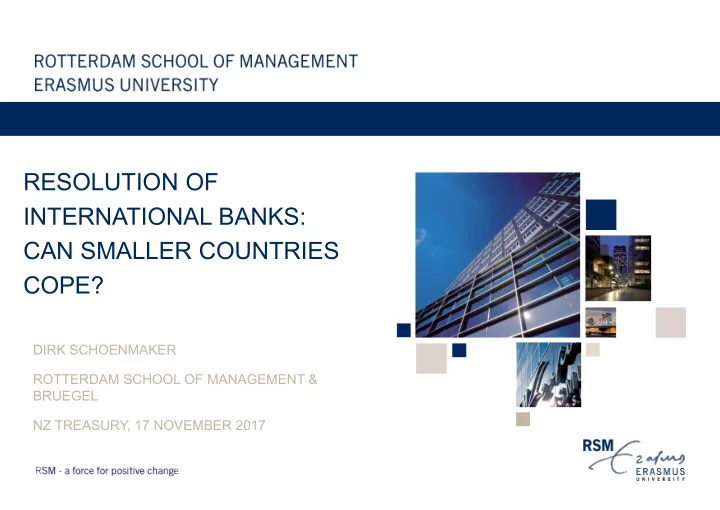

RESOLUTION OF INTERNATIONAL BANKS: CAN SMALLER COUNTRIES COPE? DIRK SCHOENMAKER ROTTERDAM SCHOOL OF MANAGEMENT & BRUEGEL NZ TREASURY, 17 NOVEMBER 2017
Outline • Reform after the Great Financial Crisis • Need for fiscal backstop -> how for international banks? • Theory: Equilibria of international banking • Empirics: International banking in practice • Policy options – ring-fecing versus burden sharing
Reform after crisis • Much has been done: More capital, including systemic surcharge G-SIBs Key principles for resolution of international banks, but soft law Bail-in: yes for idiosyncratic failures, but for large systemic banks? • We take the presence of large banks as given Still need for fiscal backstop for (large) banks • How to solve coordination failure in resolution of international banks? Hard law: ex ante binding ‘burden sharing’ agreement to organise fiscal backstop 3
Potential fiscal costs Assumptions: 1) Restore equity at 4.5% of total assets 2) Capacity to rescue up to 3 largest banks 3) Hurdle rate for fiscal capacity ≈ 8% GDP 4
Financial trilemma 5
Equilibrium A. of financial trilemma 6
A. Multinational banks with national subs • Idea: National subs are separately capitalised and managed National authorities resolve separately: MPE (multiple point of entry) • But is this equilibrium viable? Synergies from centralised risk management + 1 brand name Legal firewalls cannot prevent indirect contagion Empirics: correlation default risk parent and sub is 0.2 / 0.3 • Long run equilibrium Truly stand alone: increasingly high ring-fencing requirements No incentives for national authorities to cooperate 7
Equilibrium B. of financial trilemma 8
B. Global banks from large countries • Fiscal capacity: Small and medium countries cannot support large banks: downsizing Only large countries can afford and follow SPE (single point of entry) • But what about foreign retail branches and subs? Home country (and parent bank) may choose to support, or not Incentive host countries to ring-fence -> equilibrium A. (with MPE) Long run equilibrium • Geopolitics and powerplay: US + China may impose their model Nevertheless, host countries may not accept unilateral approach 9
Equilibrium C. of financial trilemma 10
C. Global banks with burden sharing • Idea: Give up on national policies: joint supervision + burden sharing for resolution based on hard law Facilitates SPE (single point of entry) Technically easy, but politically difficult • Tightly connected group of countries: European Banking Union Ad hoc (e.g. Joint Vienna) may work if all interests are aligned, but you cannot count on it • Long run equilibrium Regional groupings: Trans-Tasman Banking Union 11
Examples of multinational banks • Australian (parent) banks with New Zealand subs, already established before the Great Financial Crisis Cooperation in Trans-Tasman Banking Council Useful, but it is based on soft-law -> legally non-binding • US requirement for intermediate holding company • Prime examples: HSBC, Santander, BBVA HSBC: global MPE (Americas, Europe, Asia) + local SPE BBVA: MPE + SPE for Banking Union (entering Portugal?) 12
Examples of global banks • Three groups of global banks: 1. Global banks from large countries (US, China, Japan) 2. Global banks from the euro area, with (limited) burden sharing 3. Global banks from mid-sized (UK, Switzerland) -> downsizing Key is credible fiscal backstop • 1. Yes, global banks are still growing 2. Mixed, euro area is building ESM as backstop to banking system (backstop to SRF + direct recap without cumbersome conditions) • Group 3 has less credible backstop (and no political willingness) MPE is realistic option (HSBC), but more expensive Credit Suisse: on paper SPE, underlying MPE 13
Empirics Calculation: annualised change in assets, correcting for GDP 14
Risk sharing in trans-Tasman Banking Union? Risk or burden sharing can be: • Specific: geographic spread of bank assets • General: economic size (GDP) 15
Trans-Tasman Banking Union? Calculations based on joint fiscal backstop 16
Conclusions • International financial stability remains elusive – two main options 1. Soft law approach of trans-Tasman Banking Council is helpful, but will not solve coordination problem Increasing ring-fencing requirements for NZ subs 1. Burden sharing based on hard law can solve coordination failure Technically feasible, but political challenges Give up national policies (differences in resolution and dep. insur.) Differences in size: 87% vs 13% -> is New Zealand voice heard? Long-run equilibrium!
References • Schoenmaker, D. (2017), ‘Resolution of International Banks: Can Smaller Countries Cope?’, International Finance , 20, forthcoming . • Schoenmaker, D. (2017), ‘A Trans-Tasman Banking Union?’, draft paper.
Recommend
More recommend